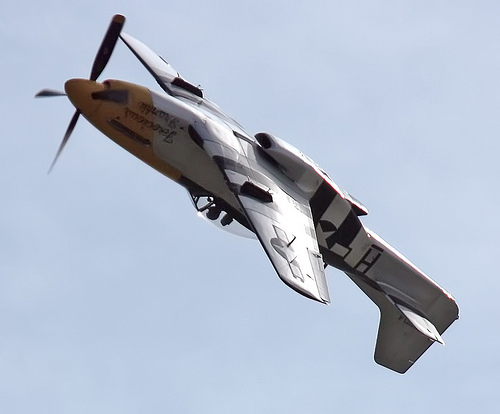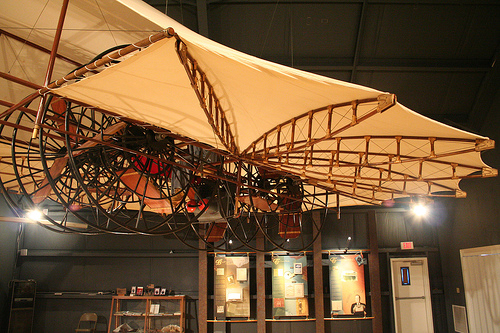A few nice prototype machine company photos I identified:
P-51D Mustang (Ferocious Frankie) at Clacton Air Show 2013

Image by Feggy Art
The North American Aviation P-51 Mustang was an American extended-range single-seat World War II fighter aircraft conceived, developed and constructed by North American Aviation (NAA) in response to a specification issued directly to NAA by the British Acquiring Commission the prototype NA-73X airframe was rolled out, even though still minus engine, 102 days following the contract was signed. The 1st production Mustangs had been used by the Royal Air Force (RAF) as tactical-reconnaissance aircraft and fighter-bombers. From late 1943, P-51Bs
(supplemented by P-51Ds from mid-1944) were employed by the USAAF’s Eighth Air Force as bomber escorts in raids over Germany, while the RAF’s 2 TAF and the USAAF’s Ninth Air Force employed the Merlin-powered Mustangs as fighter-bombers, roles in which the Mustang helped guarantee Allied air superiority in 1944. The P-51 was also in service with Allied air forces in the North African, Mediterranean and Italian theatres, and saw limited service against the Japanese in the Pacific War. At the commence of Korean War the Mustang was the United Nations’ major fighter but the role was swiftly shouldered by jet fighters, like the F-86, after which the Mustang became a specialised ground-attack fighter-bomber. In spite of being superseded by jet fighters the Mustang remained in service with some air forces until the early 1980s.
The Mustang was 1st developed to use a low-altitude rated Allison V-1710 engine and was mostly utilized in the tactical-reconnaissance and fighter-bomber roles. The definitive version, the P-51D, was powered by the Packard V-1650-7, a licence-built version of the Rolls-Royce Merlin 60 series two-stage two-speed supercharged engine, and was in a position to be utilized as a long-variety bomber escort. The P-51D was armed with six .50 caliber (12.7 mm) M2 Browning machine guns.
After Globe War II and the Korean War, numerous Mustangs were converted for civilian use, particularly air racing. The Mustang’s reputation was such that, in the early 1960s, the Ford Motor Organization made a new youth-oriented coupe which was named soon after the fighter.
The North American Aviation P-51 Mustang was an American long-variety single-seat Globe War II fighter aircraft conceived, made and built by North American Aviation (NAA) in response to a specification issued straight to NAA by the British Purchasing Commission the prototype NA-73X airframe was rolled out, though nonetheless minus engine, 102 days right after the contract was signed. The 1st production Mustangs have been utilized by the Royal Air Force (RAF) as tactical-reconnaissance aircraft and fighter-bombers. From late 1943, P-51Bs
(supplemented by P-51Ds from mid-1944) have been utilized by the USAAF’s Eighth Air Force as bomber escorts in raids more than Germany, although the RAF’s two TAF and the USAAF’s Ninth Air Force utilized the Merlin-powered Mustangs as fighter-bombers, roles in which the Mustang helped make certain Allied air superiority in 1944. The P-51 was also in service with Allied air forces in the North African, Mediterranean and Italian theatres, and saw restricted service against the Japanese in the Pacific War. At the start of Korean War the Mustang was the United Nations’ major fighter but the function was speedily shouldered by jet fighters, including the F-86, following which the Mustang became a specialised ground-attack fighter-bomber. In spite of becoming superseded by jet fighters the Mustang remained in service with some air forces till the early 1980s.
The Mustang was 1st developed to use a low-altitude rated Allison V-1710 engine and was mostly utilised in the tactical-reconnaissance and fighter-bomber roles. The definitive version, the P-51D, was powered by the Packard V-1650-7, a licence-built version of the Rolls-Royce Merlin 60 series two-stage two-speed supercharged engine, and was able to be used as a long-range bomber escort. The P-51D was armed with six .50 calibre (12.7 mm) M2 Browning machine guns.
Following Planet War II and the Korean War, many Mustangs were converted for civilian use, specially air racing. The Mustang’s reputation was such that, in the early 1960s, the Ford Motor Organization designed a new youth-oriented coupe which was named following the fighter.
Reproduced from Wikipedia beneath the GNU Inventive Commons License.
This is Ferocious Frankie.
Ezekiel Airship

Image by The Rocketeer
The Rev. Burrell Cannon, a Baptist minister and an experienced engineer, took his inspiration for a flying machine from the book of Ezekiel, in specific the passage that reads, "and when the living creatures were lifted up from the earth, the wheels have been lifted up" (Ezekiel 1:19).
The Ezekiel Airship created in Pittsburg was ingenious if not plausible. A four-cylinder gas engine drove a series of paddles. The paddles have been attached to a series of wheels inside of wheels that would produce numerous degrees of lift for a sail that covered the fuselage. Extra control of the craft could be executed by changing the angle of the sail.
By November 1902, the prototype of the Ezekiel Airship was finished. Accounts say the airship flew a complete 12 months prior to the Wright brothers’ flight. Eyewitnesses claimed the airship lurched forward and then rose into the air. The engine vibrated so badly that it was turned off and the airship gently descended back to the ground.
A former foundry employee claimed later that he and other employees have been the 1st to fly the machine. Although Cannon and firm officials were away, they took the plane out and flew it about 160 feet at a height of ten-12 feet. Fearing the loss of their jobs, the conspirators produced a pact of silence.
The minister and firm officials never in fact claimed the airship had flown. He planned to travel around the nation raising funds to continue his analysis. In Texarkana, a storm tossed the airship from its rail car perch and smashed it to the ground.
Cannon created one more attempt to develop the Ezekiel Airship in 1913 but quickly gave up. He died in Marshall in 1922. In 1987, the Pittsburg Optimist Club constructed a replica of the airship that is now housed in the Northeast Texas Rural Heritage Museum in Pittsburg. For information, call 903/856-1200 or go to www.pittsburgtxmuseum.com.